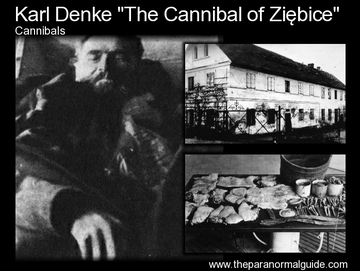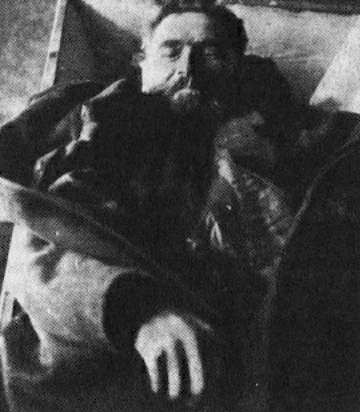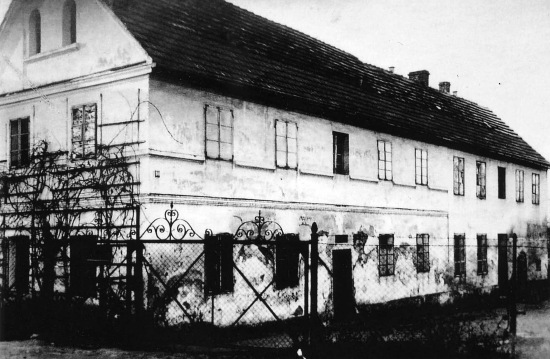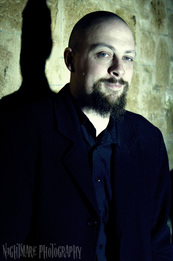
Oh, he was also a ritualistic cannibal who killed approximately forty people, pickled their flesh and sold it as ‘pork’ at the Wroclaw markets…
Admired by All
 The only known photo of Karl Denke - taken post mortem.
The only known photo of Karl Denke - taken post mortem. Not too much is known about Karl’s childhood. He was born on 12 August, 1870 in a small village in Prussia which is now a part of Poland. He ran away from home at the age of 12, but again, not much is known about Karl until he turned about 25. At this point in time his father died and left Karl a small inheritance which he used to buy a house in the small town of Münsterberg, known today as Ziebice. He tried his hand at farming for a while, but wasn’t very successful, so sold his farm and ended up supporting himself by starting a small business as a door to door salesman and market stallholder, selling all kinds of things, ranging from leather belts and shoelaces to boneless pork – as he was licensed by the butchers guild.
At the end of WWI Karl lost his savings and was forced to sell his house, but managed to continue to rent an apartment in the building on the ground floor, as well as a small shed in the backyard.
Just before Christmas, on 21 December, 1924, a homeless man named Vincenz Olivier appeared at the Munsterberg Police Station covered in blood. He swore blind that he was attacked by Karl Denke, wielding an axe. At first the police refused to believe him. Not Pappa Denke – he would never commit such an atrocity. But Vincenz was adamant, so the police had no choice but to check his story out. They questioned Karl who admitted to attacking the vagrant, saying that it was self defence as the man tried to rob him. So they could further investigate, and clear Karl’s name, they placed him in a holding cell overnight. At some point during the night Karl knew what was coming, and decided to end it all. He was found the next morning dead, having hanged himself with his handkerchief (other sources state he hanged himself with his suspenders or a bed sheet).
The Psychopath Emerges
 Denke's Munsterberg (now Zeibice) home.
Denke's Munsterberg (now Zeibice) home. What they found instead was a meat processing shop – which was scientifically confirmed to be full of human remains. It is better if we just quote directly from the source – that of a report given by the head of the Institute of Legal Medicine in Breslau, Friedrich Pietrusky dated 1926.
“The first findings made in Denke’s house during the search were bones and pieces of meat. The latter were in a salt solution found in a wooden drum. There were altogether fifteen pieces with skin. Two parts of the breast, which is strongly hairy… The remaining pieces belong to the side and back parts. The largest is about forty by twenty centimetres large. Particularly striking was a very clean anus with large parts of both buttocks....
 Tools and human remains discovered in Denke's home.
Tools and human remains discovered in Denke's home. In the third pot were found numerous pieces of human skin and parts of the aorta in a gelatinous mass. A bowl on the table in his room was filled with amber coloured fat, that appeared to be human. Biological test gave a weak-positive result for the presence of human protein.
In the shed, in which the meat pieces were found, was also a barrel full of bones that were cleaned of tendons, muscles etc. that most probably have been priorly cooked. The investigation initially revealed the existence of six forearm bones, which means that they belonged to three people at least. Another traces were found behind the shed. A part of a leg remained in the pond that Denke had dug many years before and also skeletal pieces were uncovered in the local forest. Here is the full list of what has been sent to us for examination:
- sixteen femurs of which one pair of remarkably strong ones, two pairs of very thin ones, six pairs and two left femurs; - fifteen medium-sized pieces of long bones; - four pairs of elbow bones; - seven heads of radii; - nine lower parts of radii; - eight lower parts of the elbow; - a pair of upper shinbone; - a pair of lower elbows and radii, of which extremities still remain well connected; - a pair of upper arms and a pair of upper arm heads; - a pair of collar bones; - two shoulder blades; - eight heels and ankle bones; - one hundred and twenty toes and phalanx; - sixty-five feet and metacarpal bones; - five first ribs and one hundred-fifty pieces of ribs.
…Considerably more revealing was Denke’s dental collection. We received a total of three hundred and fifty-one teeth.
These were found in a moneybag and in two tin boxes, on which "Pepper" and "Salt" was written, as well as in three paper bags, which were destined to keep pepper. They were partly sorted according to their size: the molars were in the moneybag, while the others in the two boxes and in the paper bag. In yet another paper bag were teeth that belonged probably to a single person, and in a third bag three lower incisors were found with strongly atrophic structure - this one came probably from an old individual. All teeth, with the exception of six, were well preserved.”
The remains of Karl’s victims were turning up still in the late 1940s with investigators eventually concluding that at least 40 people were murdered by this mad man.
Put together by Ashley Hall 2014





 RSS Feed
RSS Feed
